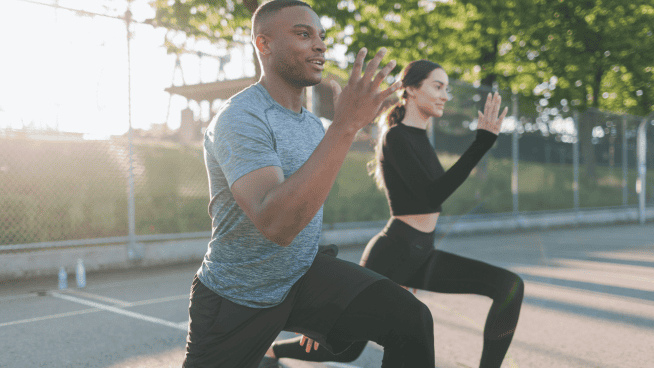3 Reasons Swimmers Should Train with Bilateral Breathing
![]()
In the never-ending debate about whether bilateral breathing is important for fast swimming, we make the case for breathing to both sides while you are in training. Below are three reasons to start breathing bilaterally in practice.
Breathing repeatedly to the same side for weeks, months and years of training can lead to a host of swimming-related injuries, not the least of which is the dreaded swimmer’s shoulder.
RELATED: Improve Your Swimming Times with These Starting Drills
The muscle imbalance that occurs over a career of turning your head in only one direction means that you have under-developed musculature on one side of your body, opening you up to overuse injuries and leading to a wealth of technical problems in the water.
But if you were paying attention over the course of the Rio Olympics, you noticed that almost every swimmer breathes every two strokes.
So what gives?
While most elite swimmers breathe every two strokes to suck in as much oxygen as possible—muscles need oxygen to function, after all—that doesn’t mean they train that way—especially over long bouts of pull, where the oxygen demands aren’t so high and they can build a balanced stroke technique.
RELATED: 5 Common Freestyle Swimming Mistakes and How to Fix Them
Here are just three reasons why you should be doing more bilateral breathing during practice:
1. It evens out muscle imbalances
Swimmers put in a lot of reps over the course of a swimming workout. If you take an athlete who performs an average of 32 strokes per 50-meter length (which is on the elite end of stroke length), over the course of a 4,500-meter practice, that amounts to 2,880 rotations of the shoulders.
That is a lot of overhead movement.
Think about it this way: If you are performing hundreds of repetitions with different weight and different technique on your left side versus your right side, what do you think will happen?
Bilateral breathing, or at the very least breathing every two strokes while facing the same side of the pool, will ensure that both sides of your body get an equal amount of stress and work.
2. It can fix common technical errors in your freestyle.
Here are just three technique problems that can be decreased when you breathe to both sides of your body during training:
Low elbow catch. Probably the worst offender among swimmers who breathe relentlessly on the same side is that one of their elbows inevitably catches lower than the other. The repercussions are significant: the catch is where propulsion originates.
Not swimming straight. Pool swimmers have the benefit of the black line to ensure that they swim straight. For triathletes and open water swimmers, however, a balanced stroke means they are more likely to swim in a straight line, meaning that they don’t have to pick their head up for half the race to check their bearings.
Body roll. Another costly error swimmers make by leaning only to one side to breathe is insufficient body roll. Swimmers naturally roll more to their breathing side, which means their stroke on the opposing side is predominantly shoulder-driven instead of hip-driven.
3. It will give you a tactical advantage over your competition.
During races, it can be supremely helpful to see where your competition is. This doesn’t matter so much for splash and dash events like the 50m and 100m races; but for anything 200m and up, when race tactics start to come into play, it can be an asset to be able to breathe to the side your competition is on.
RELATED: Olympian Swimming Skills: Five Ways to Improve Your Freestyle Form
A great example of a swimmer who was comfortable breathing to both sides was Ian Thorpe of Australia, who at one point held the world record in the 200m and 400m freestyles. At the 2004 Athens Games, while racing the Netherlands’ Pieter van den Hoogenband in the 200m freestyle, Thorpe was able to continually keep an eye on Hoogenband by breathing to the same side of the pool (but different sides of his body) over the course of the race.
[cf]skyword_tracking_tag[/cf]RECOMMENDED FOR YOU
MOST POPULAR
3 Reasons Swimmers Should Train with Bilateral Breathing
![]()
In the never-ending debate about whether bilateral breathing is important for fast swimming, we make the case for breathing to both sides while you are in training. Below are three reasons to start breathing bilaterally in practice.
Breathing repeatedly to the same side for weeks, months and years of training can lead to a host of swimming-related injuries, not the least of which is the dreaded swimmer’s shoulder.
RELATED: Improve Your Swimming Times with These Starting Drills
The muscle imbalance that occurs over a career of turning your head in only one direction means that you have under-developed musculature on one side of your body, opening you up to overuse injuries and leading to a wealth of technical problems in the water.
But if you were paying attention over the course of the Rio Olympics, you noticed that almost every swimmer breathes every two strokes.
So what gives?
While most elite swimmers breathe every two strokes to suck in as much oxygen as possible—muscles need oxygen to function, after all—that doesn’t mean they train that way—especially over long bouts of pull, where the oxygen demands aren’t so high and they can build a balanced stroke technique.
RELATED: 5 Common Freestyle Swimming Mistakes and How to Fix Them
Here are just three reasons why you should be doing more bilateral breathing during practice:
1. It evens out muscle imbalances
Swimmers put in a lot of reps over the course of a swimming workout. If you take an athlete who performs an average of 32 strokes per 50-meter length (which is on the elite end of stroke length), over the course of a 4,500-meter practice, that amounts to 2,880 rotations of the shoulders.
That is a lot of overhead movement.
Think about it this way: If you are performing hundreds of repetitions with different weight and different technique on your left side versus your right side, what do you think will happen?
Bilateral breathing, or at the very least breathing every two strokes while facing the same side of the pool, will ensure that both sides of your body get an equal amount of stress and work.
2. It can fix common technical errors in your freestyle.
Here are just three technique problems that can be decreased when you breathe to both sides of your body during training:
Low elbow catch. Probably the worst offender among swimmers who breathe relentlessly on the same side is that one of their elbows inevitably catches lower than the other. The repercussions are significant: the catch is where propulsion originates.
Not swimming straight. Pool swimmers have the benefit of the black line to ensure that they swim straight. For triathletes and open water swimmers, however, a balanced stroke means they are more likely to swim in a straight line, meaning that they don’t have to pick their head up for half the race to check their bearings.
Body roll. Another costly error swimmers make by leaning only to one side to breathe is insufficient body roll. Swimmers naturally roll more to their breathing side, which means their stroke on the opposing side is predominantly shoulder-driven instead of hip-driven.
3. It will give you a tactical advantage over your competition.
During races, it can be supremely helpful to see where your competition is. This doesn’t matter so much for splash and dash events like the 50m and 100m races; but for anything 200m and up, when race tactics start to come into play, it can be an asset to be able to breathe to the side your competition is on.
RELATED: Olympian Swimming Skills: Five Ways to Improve Your Freestyle Form
A great example of a swimmer who was comfortable breathing to both sides was Ian Thorpe of Australia, who at one point held the world record in the 200m and 400m freestyles. At the 2004 Athens Games, while racing the Netherlands’ Pieter van den Hoogenband in the 200m freestyle, Thorpe was able to continually keep an eye on Hoogenband by breathing to the same side of the pool (but different sides of his body) over the course of the race.
[cf]skyword_tracking_tag[/cf]











